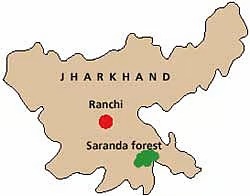Syllabus: GS-II: Judgements
Why in the news?
Recently a Supreme Court bench headed by the Chief Justice of India directed the Jharkhand government to give an undertaking to notify roughly 314.68 sq km (31,468.25 ha) as a wildlife sanctuary in the Saranda forest (West Singhbhum).
More About the News
- The order follows a long judicial and administrative trajectory — National Green Tribunal directions (July 2022), follow-up hearings in the Supreme Court since November 2024, and public interest litigation about alleged illegal mining and ecological degradation.
- The matter is now at the intersection of biodiversity protection, tribal rights, mining revenues and rule-of-law — making it a constitutional, environmental and developmental flashpoint.
About Saranda Forest
- Location: West Singhbhum district, Jharkhand, bordering Odisha.
- Meaning: Saranda means “land of seven hundred hills” in the Ho tribal language.
- Area: About 856 sq km, with 816 sq km as Reserved Forest.
- Landscape: Part of the Chotanagpur Plateau, rich in Sal (Shorea robusta) forests and rolling hills.
- Water Bodies: Drained by the Koina, Karo, and Sanjay rivers, which are tributaries of the Subarnarekha system; dotted with perennial streams that sustain wildlife and villages.
Biodiversity: Habitat for elephants, sloth bears, four-horned antelope, and diverse bird and butterfly species; contains three elephant corridors. - Importance:
- One of India’s finest Sal forest ecosystems and a vital watershed for southern Jharkhand.
- Holds about 26% of India’s iron ore reserves, making it ecologically rich yet economically pressured.
Threats: WII and ICFRE studies reported declines in species richness near mining activity and fragmentation of habitats of the forest area.

About the case before the Supreme Court
- Origin: A petitioner asked for declaration of an eco-sensitive zone and sanctuary status for Saranda/Sasangada, pointing to ecological sensitivity and past illegal mining.
- Petitioner’s Claim: Saranda was already a “game sanctuary” (1968, Bihar), deemed protected under the Wildlife (Protection) Act, 1972.
- NGT direction (July 2022): NGT asked the state to consider declaring the area a sanctuary; the state did not act, prompting further litigation.
- Supreme Court involvement: Between Nov 2024 and Oct 2025 the CJI-led bench repeatedly asked Jharkhand to move forward.
- The Court in October 2025 ordered an undertaking to notify 314.68 sq km as a wildlife sanctuary while clarifying that valid and subsisting mining leases already granted and operational would not be affected.
- Contested points: Whether the area was “deemed” a sanctuary under the Wildlife Protection Act, 1972 (because of pre-1972 declarations), the balance between conservation and mining revenues, compliance with Forest Rights Act (FRA), 2006, and protection of tribal customary rights in Fifth Schedule / PESA areas.
- Intervenors & evidence: Wildlife Institute of India (WII) and ICFRE carrying-capacity studies, the Justice M. B. Shah Commission report on illegal mining, and affidavits from forest authorities formed the evidentiary core.
Significance of the Saranda landscape — ecology, species & connectivity
- Extent & forest type: Saranda forest division covers ~856 sq km; ~816 sq km is reserved forest.
- It is one of India’s most extensive Sal (Shorea robusta) forests and a biodiversity hotspot at the Jharkhand–Odisha junction.
- Biodiversity: Habitat for elephants, four-horned antelope, sloth bear, myriad birds, butterflies and other fauna.
- Tigers have been sighted historically (not permanently resident recently).
- Elephant ecology: Jharkhand’s latest estimates (Oct 2025) place the state elephant population at ~217, with Saranda historically part of elephant ranges and containing three important corridors connecting to neighbouring forests.
- Loss of corridor integrity has pushed elephants eastwards to Odisha and Chhattisgarh.
- Ecological services: Watershed protection, carbon sequestration, soil conservation and sustaining tribal livelihoods depend on intact forests.
Mining, revenue stakes and illegal extraction — the economic dimension
- Mineral wealth: Saranda region accounts for roughly 26% of India’s iron-ore reserves. Mining (legal and illegal) has been economically significant for the state.
- Current production neighbouring Saranda: Active mines in and around the region reportedly produce 10–15 million tonnes/year (~5% of India’s annual iron ore output).
- Illicit mining findings: Justice M. B. Shah Commission uncovered large-scale illegal extraction with estimated illegal removal of iron ore valued at ₹14,403 crore and manganese worth ₹138 crore.
- Policy response: Post-Shah Commission, the Union Environment Ministry proposed a sustainable mining plan with “go/no-go” zones and an annual cap (64 Mtpa) with conditional increases if mining is sustainable — but implementation, monitoring and enforcement remain contested.
Arguments of the Jharkhand government & industry stakeholders
- State position: The Jharkhand government told the Court it supported sanctuary status in principle but insisted that tribal rights (Ho, Munda and allied Adivasi groups, including PVTGs) under FRA 2006, PESA, and Fifth Schedule protections must not be violated.
- The state also stressed the revenue importance of mining for development and employment.
- Industry’s concern: Steel Authority of India Ltd (SAIL) and other miners argued sanctuary notification should not impair valid and subsisting mining leases and sought legal protection for operational mines and investments.
- Court’s interim stance: While directing notification, the Supreme Court has clarified that operational mines with valid leases will not be affected — attempting to protect vested legal rights while securing conservation.
Conservation challenges posed by mining & anthropogenic pressures
- Habitat fragmentation: Mining proximate to forests reduces contiguous habitat and increases edge effects, lowering species richness (WII findings).
- Corridor disruption: Mining, roads and settlements sever elephant corridors, increasing human–elephant conflict and range contraction.
- Pollution and degradation: Dust, waste dumps, water extraction and soil erosion associated with mining degrade ecosystem functions.
- Enforcement deficit: Illegal mining historically flourished due to weak enforcement, lack of transparency in leases and collusive networks.
Way forward
1. Legal and administrative measures
- Immediate notification with safeguards: Notify the sanctuary as directed but explicitly carve out (and map) valid existing leases that are operational — while ensuring strict environmental compliance and progressive rehabilitation plans.
- FRA & Fifth Schedule compliance: Before any eviction or restriction, conduct community rights mapping, verify individual/ community claims under FRA, and provide legally mandated consultation and consent mechanisms under PESA.
- Environment & Social Impact Assessment (ESIA): Mandate independent ESIA for any ongoing or proposed mining near the sanctuary boundary, with public disclosure and grievance redress.
2. Sustainable mining governance
- Strict “go/no-go” zoning: Implement the Union’s sustainable mining plan with legally binding no-mining zones within core and corridor areas; allow mining only in buffer zones under strict conditions.
- Cumulative impact assessment: Assess cumulative ecological impacts of all mining leases within the landscape rather than single-mine approvals.
- Rehabilitation and progressive restoration: Mine closure plans must include financial assurance (trust funds/ bank guarantees) for ecological restoration and livelihood compensation.
3. Community-centred conservation
- Community Conserved Areas (CCAs): Support tribal stewardship models and CCAs, leverage traditional ecological knowledge for habitat management and anti-poaching.
- Livelihood alternatives: Provide livelihood transition plans (eco-tourism, NTFP value chains, agro-forestry, wage employment under MGNREGA) financed by mining-derived conservation cess.
- Benefit-sharing: Create mechanisms for mining revenue sharing with local panchayats for education, health and conservation incentives.
4. Ecological restoration & corridor security
- Corridor restoration programme: Map, restore and legally secure elephant corridors linking Saranda with neighbouring forests; enact anti-encroachment drives with rehabilitation.
- Monitoring & science: Institutionalise long-term monitoring (WII/ICFRE partnerships), camera traps, elephant movement telemetry and biodiversity indices.
5. Transparency, accountability & prosecution deterrence
- Open data on leases & revenues: Public registry of leases, production, royalty payments and environmental compliance.
- Anti-corruption & prosecution: Pursue investigations into past illegal mining, recover proceeds and prosecute malfeasance to deter repeat violations.
6. Inter-state and central coordination
- Regional conservation plan: Coordinate with Odisha and Chhattisgarh for landscape-level conservation and elephant corridor management.
- Central support: Use central funds (CAMPA, Project Elephant, National Wildlife Protection) to finance restoration and community resilience.
Conclusion
Saranda is a classic test of India’s ability to balance ecological stewardship with legitimate development and tribal rights. The Supreme Court’s directive to notify a sanctuary recognises the urgency of protecting one of the country’s finest Sal ecosystems, but conservation cannot be implemented as an assault on legally recognised tribal rights or as an excuse for arbitrary curbs on legitimate economic activity. A durable solution will be legally robust sanctuary notification coupled with transparent zoning, ESIA-based mining governance, restitution for past wrongs, ecological restoration and community empowerment. That is the only path that secures both biodiversity and justice.
Sample mains question
“The Saranda forests controversy highlights a fundamental contest between biodiversity conservation and mining-driven development. Critically examine the competing claims and recommend a policy framework that balances ecological protection, tribal rights and sustainable resource use.”
Share This Story, Choose Your Platform!
Start Yours at Ajmal IAS – with Mentorship StrategyDisciplineClarityResults that Drives Success
Your dream deserves this moment — begin it here.


